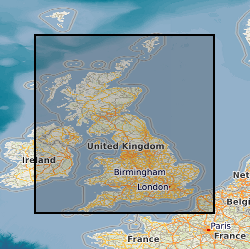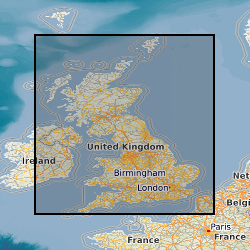Shapefile
Type of resources
Available actions
Topics
Keywords
Contact for the resource
Provided by
Years
Formats
Representation types
Update frequencies
Scale
Resolution
-

This dataset is a characterisation of the soil and rocks and the potential bulking factor (likely excavated volume increases) at Formation (local to regional) level for Great Britain. The data is categorised into Class, characteristics of similar soils and rocks and Bulking Factor, range or ranges of % bulking. The excavation of rocks or soils is usually accompanied by a change in volume. This change in volume is referred to as ‘bulking’ and the measure of the change is the ‘bulking factor’. The bulking factor is used to estimate the likely excavated volumes that will need to be moved, stored on site, or removed from site. It is envisaged that the 'Engineering Properties: Bulking of soils and rocks' dataset will be of use to companies involved in the estimation of the volume of excavated material for civil engineering operations. These operations may include, but are not limited to, resource estimation, transportation, storage, disposal and the use of excavated materials as engineered fill. It forms part of the DiGMap Plus dataset series of GIS layers which describe the engineering properties of materials from the base of pedological soil down to c. 3m depth (ie the uppermost c.2m of geology). These deposits display a variable degree of weathering, but still exhibit core engineering characteristics relating to their lithologies.
-
This is a digital map containing polygons representing areas of vegetation within Roudsea Wood National Nature Reserve (NNR), Cumbria. Vegetation was mapped in the field on a basemap as parcels according to tree cover type, tree stocking rates and ground flora communities. The map covers the western side of the reserve (the woodland). The field map was originally created by staff at the Nature Conservancy’s Merlewood Research Station, Grange-over-Sands, Cumbria in 1962 and digitized by the Centre for Ecology & Hydrology from the original field map in 2019. Full details about this dataset can be found at https://doi.org/10.5285/a8d710fb-177d-467c-b2c1-2b215f582d2c
-
This dataset comprises forest stand and species occurrence data for a selection of non-native species collected in the UK Sovereign Base Areas (SBA) of Cyprus in October 2015 and March 2017, with a particular focus on the area surrounding Lake Akrotiri in the Western SBA. The main focus for mapping was stands of Acacia saligna, Casuarina cunninghamiana, the eucalypts Eucalyptus camaldulensis and E. gomphocephala, and the forb Symphyotrichum squamatum. The typical accuracy of data capture was around 10-15 m precision, varying according to the presence of forest canopy. Full details about this dataset can be found at https://doi.org/10.5285/7c84e06d-bb1a-4aac-b1d7-33c11310d8a0
-
This dataset contains the areas affected by landslides triggered by Typhoon Parma in the area of Itogon (Benguet, Philippines) between the 2nd and 5th October 2009. The polygons were mapped using Google Earth imagery dated 31 December 2003 for pre-event and images and 31 December 2009 for post-event images. The area has an extension of 150 km2. Full details about this dataset can be found at https://doi.org/10.5285/2e15dbd2-71c3-4e86-aa90-6029d37bd417
-
This dataset records the Saiga antelope die-off and calving sites in Kazakhstan. It represents the locations (and where available dates) of (i) die-offs and (ii) normal calving events in the Betpak-dala population of the saiga antelope, in which three major mass mortality events have been recorded since 1988. In total, the data contains 214 saiga die-off and calving sites obtained from field visits, aerial surveys, telemetry and literature. Locations derived from field data, aerial surveys or telemetry are polygons representing the actual size and shape of the die-off or calving sites; locations sourced from the literature are point data around which buffers of 6km were created, representing the average size of calving aggregations. Of the 214 locations listed, 135 sites for which environmental data were available were used to model the probability of a die-off event. The collection and use of these data are written up in more detail in papers which are currently under review (when published links will be added to this record). Saiga antelope are susceptible to mass mortality events, the most severe of which tend to be caused by haemorrhagic septicaemia following infection by the bacteria Pasteurella multocida. These die-off events tend to occur in May during calving, when saigas gather in dense aggregations which can be represented spatially as relatively small sites. The Betpak-dala population is one of three in Kazakhstan, located in the central provinces of the country (see map). Full details about this dataset can be found at https://doi.org/10.5285/8ad12782-e939-4834-830a-c89e503a298b
-
This dataset consists of the vector version of the Land Cover Map 2000 for Great Britain, containing individual parcels of land cover (the highest available resolution). Level 2 & Level 3 attributes are available. Level 2, the standard level of detail, provides 26 LCM2000 target or ('sub') classes. This is the most widely used version of the dataset. Level 3 gives higher class detail. However, the quality of this level of detail may vary in different areas of the country, requiring expert interpretation. The dataset is part of a series of data products produced by the Centre for Ecology & Hydrology known as LCM2000. LCM2000 is a parcel-based thematic classification of satellite image data covering the entire United Kingdom. The map updates and upgrades the Land Cover Map of Great Britain (LCMGB) 1990. Like the earlier 1990 products, LCM2000 is derived from a computer classification of satellite scenes obtained mainly from Landsat, IRS and SPOT sensors and also incorporates information derived from other ancillary datasets. LCM2000 was classified using a nomenclature corresponding to the Joint Nature Conservation Committee (JNCC) Broad Habitats, which encompasses the entire range of UK habitats. In addition, it recorded further detail where possible. The series of LCM2000 products includes vector and raster formats, with a number of different versions containing varying levels of detail and at different spatial resolutions. Full details about this dataset can be found at https://doi.org/10.5285/b79e887e-a2a7-4224-8fd7-e78066b950b3
-
This data set provides a spatial stratification of forest cover into discrete vegetation classes according to the High Carbon Stock (HCS) Approach. The data set covers the Stability of Altered Forest Ecosystems (SAFE) project site located in Sabah, Malaysian Borneo. Data were collected in 2015 during a project which was included in the NERC Human-modified tropical forest (HMTF) programme. Full details about this dataset can be found at https://doi.org/10.5285/81cad1ef-b5cc-4592-a71f-204a5d04b700
-
Data are presented showing change in saltmarsh extent along 25 estuaries/embayments in six regions across Great Britain, between 1846 and 2016. Data were captured from maps and aerial photographs. Marsh extent was delineated a scale of 1:7,500 by placing vertices every 5 m along the marsh edge. Error introduced from: (i) inaccuracies in the basemap used to georeference maps and aerial photographs; (ii) the georeferencing procedure itself; (iii) the interpreter when placing vertices on the marsh edge; and (iv) map and photo distortions that occurred prior to digitisation were calculated and used to estimate the root mean square error (RMSE) in areal extent of each marsh complex. Measures of marsh extent were only recorded if maps and aerial photographs were available for the entire estuary/embayment. Data was collected as part of a study on the large-scale, long-term trends and causes of lateral saltmarsh change. The data was used in the analysis for Ladd et al. (2019). C. Ladd and M.F. Duggan-Edwards carried out the collection and processing of the saltmarsh extent data. All authors contributed to the interpretation of the data. The work was carried out under the NERC programme - Carbon Storage in Intertidal Environment (C-SIDE), NERC grant reference NE/R010846/1. Full details about this dataset can be found at https://doi.org/10.5285/03b62fd0-41e2-4355-9a06-1697117f0717
-
This dataset contains the areas affected by landslides triggered by Typhoon Mangkhut in the area of Itogon (Benguet, Philippines) between the 13th and 15th of September 2018. The polygons were mapped using very high-resolution satellite imagery from before and after the typhoon. The pre-typhoon images were captured on 18/02/2018 and the post-typhoon images were captured on 02/03/2019 using the World-View 2 satellite. Google Earth imagery was also used as a supplementary source. The study area covers 570 km2. Full details about this dataset can be found at https://doi.org/10.5285/32765a61-8510-4dfc-b7c7-58bad12f8497
-

This dataset is a characterisation of discontinuity types found within rocks and soils in Great Britain. Discontinuities are breaks, fractures or planes of weakness in the rock mass. The dataset includes type, frequency and orientation of discontinuities within rock and soil materials at formation (local to regional) scale. The discontinuities are classified in 3 categories: stratification (bedding planes), foliation (mineral banding) and rock mass description. The dataset aims to facilitate the preliminary research for planning and design of buildings, infrastructure and resource extraction. It forms part of the DiGMap Plus dataset series of GIS layers which describes the engineering properties of materials from the base of pedological soil down to c. 3m depth (ie the uppermost c.2m of geology). These deposits display a variable degree of weathering, but still exhibit core engineering characteristics relating to their lithologies.
 NERC Data Catalogue Service
NERC Data Catalogue Service